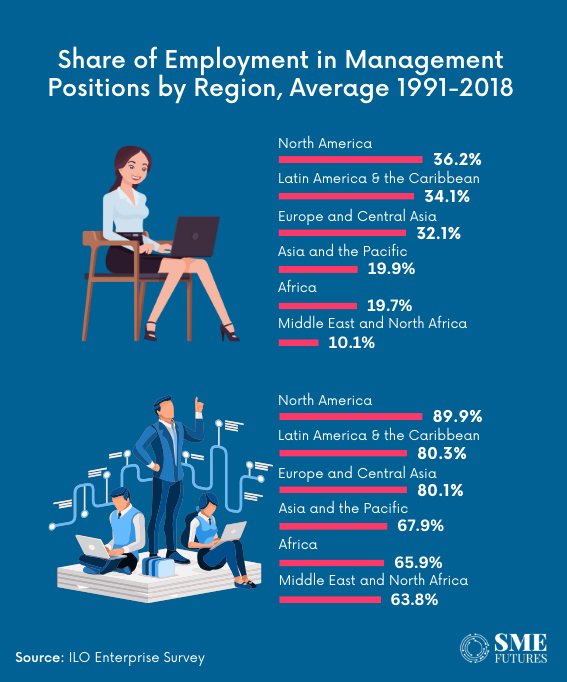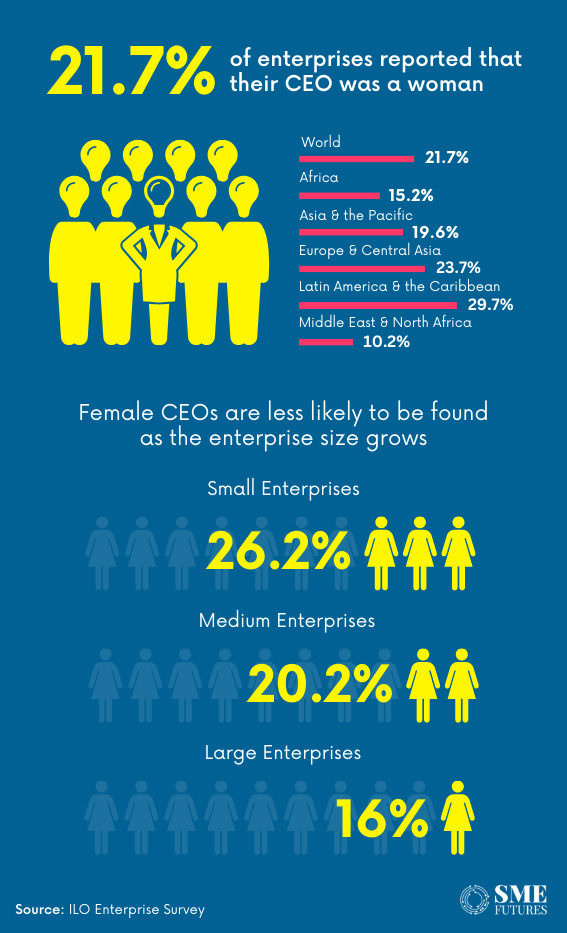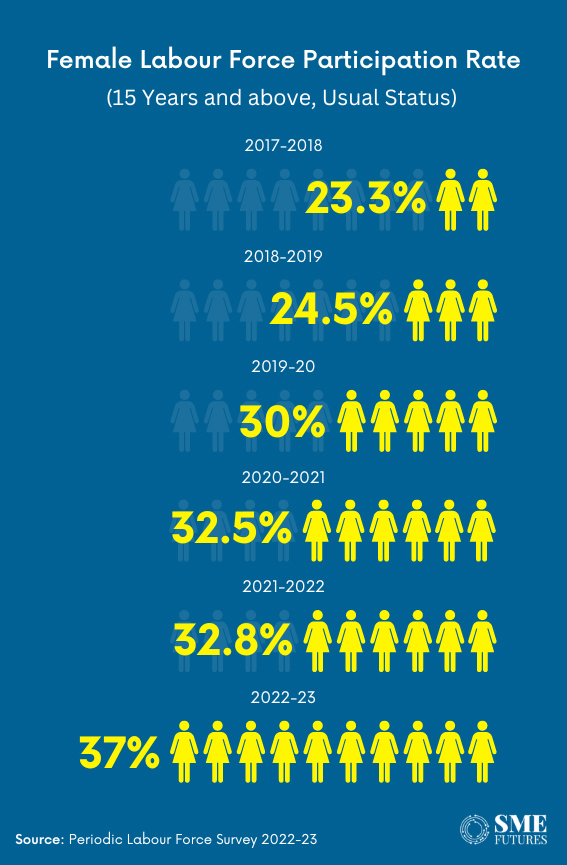The ‘glass ceiling’ is an invisible barrier beyond which minorities, particularly women in middle-level management, never advance. It refers to the situation in which a qualified person desiring to progress within the hierarchy of his or her organisation is halted at a lower level due to prejudice, mostly based on gender or ethnicity.
This ceiling is invisible, seems unbreakable and is one of the main causes of women’s under-representation in top-level management. However, Indian women have been breaking through this barrier, including Indra Nooyi, Simone Tata, and Kiran Mazumdar-Shaw.
Glass ceilings occur for four basic reasons: self, family, organisations, and society.
At the personal level, people frequently have self-limiting ideas and actions that inhibit them from actively seeking power and position.
Rajshree Nambiar, Co-founder, MD & CEO of Ecofy says, “In my opinion, the so-called glass ceiling is often a self-imposed mental barrier that women unintentionally create for themselves. In challenging this perception, it is imperative for women to seize opportunities and fully exploit their potential in every task at hand.”
She goes on to say that role modelling, increased diversity, equal chances, and a positive work atmosphere can all help to break down this mental barrier.
Families can be a source of strength or weakness, but it cannot be denied that family obligations influence human decision-making, especially in conservative countries. Women are frequently assigned more duties than men, are usually expected to choose between their professions and marriage and be the primary carers of their children.
According to Periodic Labour Force Survey data, in India, married women (25-49 years) have a much lower employment proportion under the Usual Principal Status (UPS) than the Usual Principal and Subsidiary Status (UPSS).
New Zealand’s Prime Minister Jacinda Ardern’s decision not to run for re-election may have surprised some, but it highlights the ongoing scrutiny women face at the highest levels, as well as the expectations placed on new mothers.
Similarly, expecting women to be the primary caregivers to the elderly and fulfilling other household responsibilities only reinforces the glass ceiling.
Society also poses challenges to women in the form of gender stereotyping and other forms of discrimination.
Talking about the glass ceiling, in addition to the challenges faced by women at the level of self, family and society, organisations play the most important role.
The first obstacle is gendered leadership, in which men and women face differing evaluation standards. According to Harvard Business Review research, female executives are expected to be both warm and friendly (traditionally associated with women) and competent or tough (traditionally associated with men and leaders). The problem is that these characteristics are frequently viewed as opposites.
Other organisational issues include micro-discrimination, faculty assumptions (due to stereotypes, biases, and lack of communication), a lack of opportunities, and negative attitudes towards female management.
Although we have defined the challenges faced by women at different levels separately, generally these problems are often fused together.
Data points from the world
Female labour force participation
According to the World Bank, female labour force participation has been steady over the last three decades, with around half of working-age women currently participating. However, women worldwide have lower earning potential than men.
Women are also less likely to labour for pay or actively seek employment. The percentage of women’s global labour force participation is little over 50%, compared to 80% for men. Women are less likely to work in formal jobs, and they have lower prospects for business growth or professional advancement. Also, when women work, they earn less.
Women in leadership positions globally
The WEF reports that while women make up roughly 50% of the labour population, their representation in senior leadership positions (C-suite) was only 32.2% in 2023. Women continue to lag behind men in senior leadership positions across all industries, particularly in manufacturing (24.6%); agriculture (23.3%); supply chain and transportation (23.0%); oil, gas, and mining (18.6%); and infrastructure (16.1%).
The International Labour Organisation in its report titled ‘The Business Case for Change (1991-2019)’ demonstrates the share of employment in management positions by region from 1991–2018 as shown below.

The table shows that the Middle East and North Africa had the highest average rate of males in managerial positions during this period (89.9%), followed by Africa (80.3%) and Asia and the Pacific (80.1%).
According to the same ILO poll conducted between 1991 and 2019, only 21.7% of businesses reported having a female CEO.

Further, the report indicated that female CEOs were less likely to be found as the enterprises grew. Both the indicators are low for the Asia and Pacific regions.
Magnitude of problem in India
According to the Periodic Labour Force Survey Report 2022-23, the country’s female labour force participation rate increased by 4.2% to 37.0% in 2023, as measured by the ‘usual status’ concept.

The graph shows a constant increase in women’s engagement in the Indian workforce, but it is still low when compared to the global average Labour Force Engagement Rate of 47.3% in 2022.
However, it is not only labour participation that indicates the presence of a glass ceiling; we must also consider how many top-level positions are accessible or provided to women in India.
Women in boardrooms
Professor Promila Agarwal of IIM Ahmedabad’s research report on leadership gender balance in NSE 200 companies reveals a worrying trend.
When it comes to Indian boardrooms, there are only a few women at the top; according to the survey, only 5% of women have made it to top management, with another 7% making it to senior executive positions.
The study also found that gender disparities persist in pay packages, with women earning 17% less than their male counterparts.
According to the World Bank’s research, women’s labour-force participation in India was substantially lower than in the United States (55%) and China (60%) in 2019.
Another FICCI analysis estimates that attaining gender equality in India will result in an additional US$700 billion in GDP by 2025.
Although the number of female executives in businesses has increased over time, the majority of executive positions held by women remain support jobs. For example, the Head of Human Resources, the Head of Legal Function, etc.
Other indices also tell the same story. India ranks 127th out of 146 nations in the World Economic Forum’s Global Gender Gap Report for 2023.
However, there is not much uniformity across sectors and the concept and meaning may be different for different stakeholders.
Deepika Loganathan, Co-founder and CEO of HaiVE.Tech says, “Glass ceiling? We see a future of empowered women in tech. This Women’s Day let’s shatter it together. At HaiVE, we acknowledge the complex reality of the glass ceiling for women in enterprise technology. While undeniable progress has been made, implicit biases and systemic hurdles still exist, impeding women’s rise to leadership positions.”
“However, we see this not as a challenge to overcome, but as an opportunity to unlock the full potential of women in tech. By actively cultivating diversity, equality, and inclusion within our organisation and the industry, we can shatter the limitations and empower women to excel,” she adds.
Dr. Somdutta Singh, Founder and CEO of Assiduus Global Inc and Ex-Member of the Niti Aayog says, “When we speak of the glass ceiling, we not only have decades of debate, but it constantly sparks agitation. While progress has been made, the question remains: Is it fact or simply fiction?”
Progress, but slow
According to McKinsey & Company, women hold 24% of executive committee seats globally, showcasing a positive trend but a significant gap as well. At the CEO level, the disparity is even wider. Catalyst reports that women held only 8.8% of CEO positions in Fortune 500 companies in the USA, as of 2023.
Men significantly outnumber women at the very top of corporate hierarchies. This disparity reveals that while the glass may be thinner, the ceiling still exists, feels Singh.
In fact, whether denied promotions for seemingly arbitrary reasons or passed over for opportunities despite their qualifications, too many women still hit that invisible barrier. This persistent gap is a testament to the continued existence of systemic barriers and biases that prevent full gender equality in the workplace.
“The problem lies not only in outright discrimination but also in biases that remain pervasive, if often unconscious,” Singh contends.
From assumptions about work-life balance to the perception of female leadership styles, these subtle biases continue to hinder women’s advancement. Anecdotal evidence reveals that many women face invisible barriers, experiencing unjustified denials of promotion or being overlooked for opportunities despite qualifications, she adds.
While there’s reason for optimism, declaring the glass ceiling fictional disregards the very real obstacles that many women still face. It’s a matter of both fact and degree, where progress must be measured alongside the work that remains to be done to truly shatter the remaining barriers. While some progress is evident, it’s crucial to acknowledge the challenges that persist and work towards dismantling systemic barriers and biases to achieve true gender equality in leadership positions.











